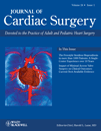CNS Effects on Cardiomyoplasty in Goats: Preliminary Study
Abstract
Following cardiomyoplasty, the latissimus dorsi (LD) muscle contracts in response to both pacemaker and central nervous system (CNS) derived action potentials. To evaluate the effect of this dual stimulation on cardiac function, six goats (56 kg to 80 kg) underwent treadmill tests 4 to 5 months after surgery. Sonomicrometer crystals were used to measure changes in the left ventricular short-axis dimension (LVSAD) and regional length changes in the LD muscle. Pacing mediated stimulation resulted in 17 ± 4% fractional shortening of the muscle pedicle lasting 400 ± 17 msec. Walking at speeds of 0.8 and 2.4 km/hr produced muscle contractions of variable duration and intensity. LVSAD was decreased by both pacing (14%) and walking (up to 10%). Pacing in combination with walking caused erratic muscle contractions with concomitant changes in LVSAD suggestive of impaired ventricular filling. No arrhythmias were noted during exercise.




